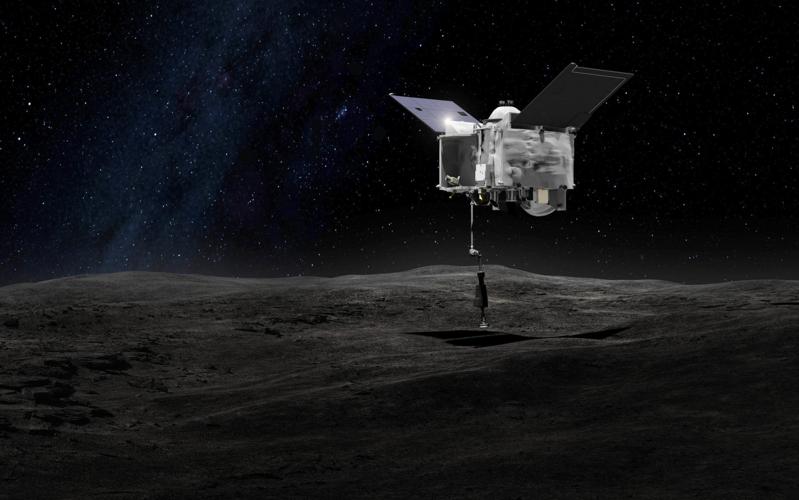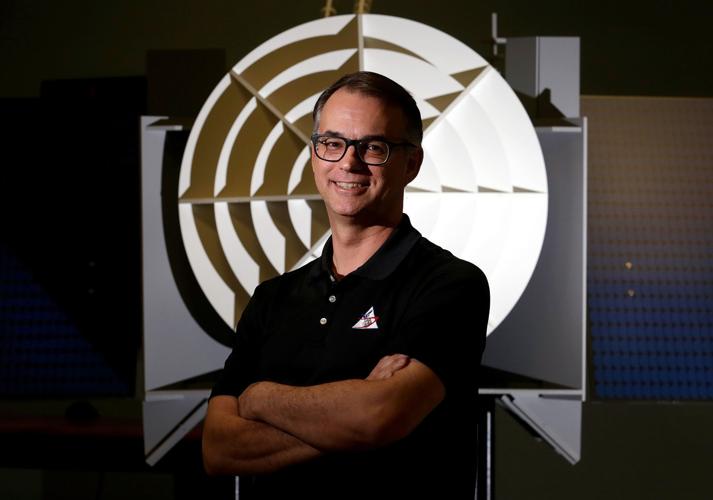(UPDATED AT 10:30 A.M.) UA scientists cheered Monday morning when the OSIRIS-REx spacecraft arrived at the asteroid Bennu, an important milestone in the UA-led mission.
The spacecraft will now spend the next 1½ years orbiting the asteroid preparing for its touch-and-go maneuver onto Bennu, where it will hopefully collect a sample from its surface.
School officials and scientists working on the mission gathered at the Stevie Eller Dance Theater at the UA on Monday morning to wait for the signal that the spacecraft, which launched in 2016, safely arrived. The signal of arrival came from the spacecraft at around 10:08 a.m. to cheers and high fives in Tucson and at mission control at Lockheed Martin in Littleton, Colorado.
"This is the start of the grand adventure that is OSIRIS-REx," said UA Professor Dante Lauretta, the mission's principal investigator.
NASA’s OSIRIS-REx has traveled 1.25 billion miles for more than two years to chase down the Bennu. On Monday, the spacecraft — now 80 million miles from home — caught up to its target.
The main objective of the $1 billion University of Arizona-led mission is to collect a sample of the asteroid, which contains materials left over from the formation of the solar system 4½ billion years ago, and return it to Earth for study. Scientists will learn about the origins of the solar system and potentially of life itself. Understanding Bennu’s properties will even prepare us for planetary defense.
But there was no touchdown upon arrival at Bennu. To successfully collect a pristine sample, OSIRIS-REx must still perform 1½ years of measurements, mapping and data collection before locating the ideal sample site and heading in for the retrieval procedure.
OSIRIS-REx, short for Origins Spectral Interpretation Resource Identification and Security-Regolith Explorer, was the third mission chosen for NASA’s New Frontiers Program. The University of Arizona’s Lunar and Planetary Laboratory leads the mission’s science team and the science observation, planning and data processing.
Arrival at Bennu
On Monday morning, pre-programmed commands guided OSIRIS-REx as it approached Bennu. On the ground, mission control could only monitor the spacecraft’s performance via the NASA Deep Space Network, said Lauretta, the mission’s principal investigator.
Fortunately, if anything went wrong — the engines could have fired in the wrong direction or for the wrong amount of time, for example — the team could still make corrections later on. “There’s a lot of wiggle room,” Lauretta said. However, such a setback would change the timeline and how OSIRIS-REx returns home.
Next, the spacecraft will fly over Bennu’s north pole, equator and south pole five times to understand its mass, which is needed to go into orbit around the asteroid, said Mike Nolan, head of the mission’s science team.
This procedure will take nearly four weeks. On Dec. 31, the spacecraft can then begin orbiting from about a mile out along the line that separates day and night on the asteroid, called the terminator. This is done to evenly distribute the pressure from the light of the sun on the spacecraft, Nolan said.
The terminator isn’t a great place to understand the surface of Bennu and choose a sample site, so the craft will come out of orbit multiple times in the next 18 months to make swooping passes around other sides of Bennu from varying distances to collect data, snap photos and get a more detailed understanding of the asteroid.
Bennu was discovered in 1999 and is the smallest planetary body that any spacecraft has ever orbited. It is 1,650 feet wide, which is slightly larger than the Empire State Building. Bennu travels at an average speed of 63,000 mph around the sun and has the most well-understood orbit of any asteroid.
The approach phase of the mission began when Bennu first appeared to the spacecraft as a dot of light Aug. 17 from 1.4 million miles away. Since then, OSIRIS-REx has been snapping photos as it puts on the brakes to learn as much as it can before arrival.
Nolan said he was very pleased at how accurate his computer model of Bennu’s shape turned out. “One important thing for me to figure out is how well-made the models are based on ground-based telescopic measurements and how well we can trust them,” he said.
“The good news is that the asteroid for the most part has behaved well. There are no hazards in the surrounding environment and it’s the shape and size and rotating like we thought,” Lauretta said.
But the lack of surprises doesn’t mean the data the science team are gathering isn’t still fascinating, he said. Published scientific studies are already on the horizon as a result of the mission data gathered so far.
Asteroid operations
Monday marks the beginning of asteroid operations, which will occur in four phases.
The first phase, called the preliminary survey, will search for dust plumes and natural satellites around Bennu. During the next phase, called orbital A, the craft will transition from star-based navigation to landmark-based navigation using Bennu’s surface features.
The third phase, the detailed survey, will use multiple instruments onboard to map Bennu and determine its physical properties. The last phase, called orbital B, will continue to map the surface at high resolutions using lasers until a sample site is chosen.
There are four questions to ask before choosing a sample site: First, can the spacecraft get there without encountering any physical limitations? Second, is it safe to go there without damaging the spacecraft? Third, is the material small enough to collect with the instrument?
Lastly, “Having met all other criteria, which has the most interesting sample to bring back with the most scientific value?” Nolan said.
The Touch-And-Go Sample Acquisition Maneuver, TAGSAM for short, is the “most nail-biting” part of the mission, Lauretta said. It is scheduled for July 4, 2020.
OSIRIS-REx will extend its 11-foot arm, make contact with the dusty asteroid surface and produce a burst of nitrogen gas to kick up material into the sample head.
The maneuver will last only five seconds, with the sampling head bouncing against the asteroid’s surface in a pogo-stick-like motion, according to Lockheed Martin.
The team hopes to capture at least 2.1 ounces of material and up to 4½ pounds. OSIRIS-REx is capable of making three attempts.
Much work has gone into making sure the sample is as pristine as possible. Throughout construction of the spacecraft, any materials used to build or clean the spacecraft were meticulously documented. “There’s a record of anything not from the asteroid,” Lauretta said.
Heading home
OSIRIS-REx will delay heading home until Bennu is in an ideal spot to get the spacecraft home on time, March 3, 2021 .
The sample-return capsule will be ejected and fall to the Utah desert on Sept. 24, 2023, while the spacecraft is deflected into a stable orbit around the sun.
On Earth, the primordial rocks and dust will be analyzed down to the atomic level to further determine the asteroid’s chemical composition. Sample scientists will look for organic compounds such as amino acids and sugars, the building blocks for life.
Why Bennu?
“The most common asteroids tend to be much rockier. They look like volcanic rocks that have been melted and processed,” Nolan said. “We wanted to go to something more primitive, something less processed.”
Pieces of asteroids fall on Earth as meteorites all the time. But those that make it to the surface are of that harder, rockier material, Nolan said. Since those meteorites fall randomly from the sky, we don’t know exactly where they come from.
Bennu, on the other hand, is made of a softer material that has never made it to the surface of the Earth. What’s more, scientists will know exactly where Bennu samples came from, because they carefully collected it themselves, giving them more information about what happened to it in the past.
“There’s a chance there’s something never seen before,” Nolan said.





